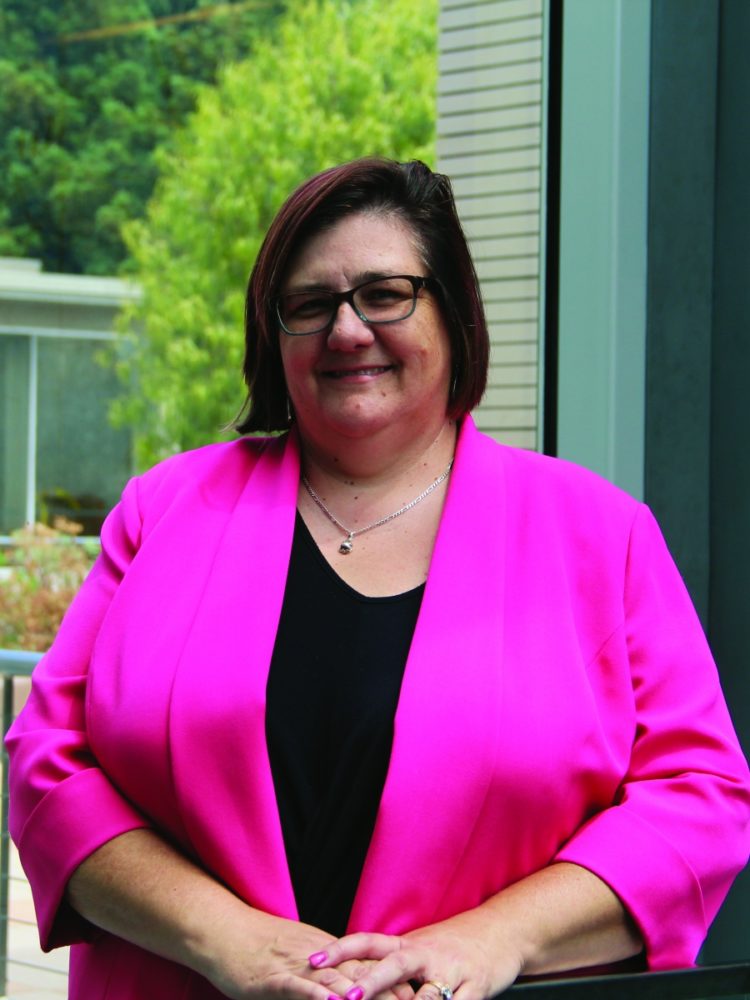Creating champions requires detailed focus on the journey. Kathy Lord, SVP of Sage People explains how asking hard questions, embracing feedback and making personal connections with your customers can move the sales journey from prospect to champion.
Want to see more content like this? Join us at SaaStr Annual 2020.
Kathy Lord | SVP @ Sage People
FULL TRANSCRIPT BELOW
All right, so who here has kids and is excited that school’s back in session for folks? Is everyone excited about that? I was excited until Sunday night when my son brought home the first cold of the new school year. And so you’ll have to pardon my voice a little today. I’ve got a pocket full of cough drops, but we’re going to hope that it lasts for the full 30 minutes today because I’m really excited to share with you today what I call that playbook of going from prospect to customer champion.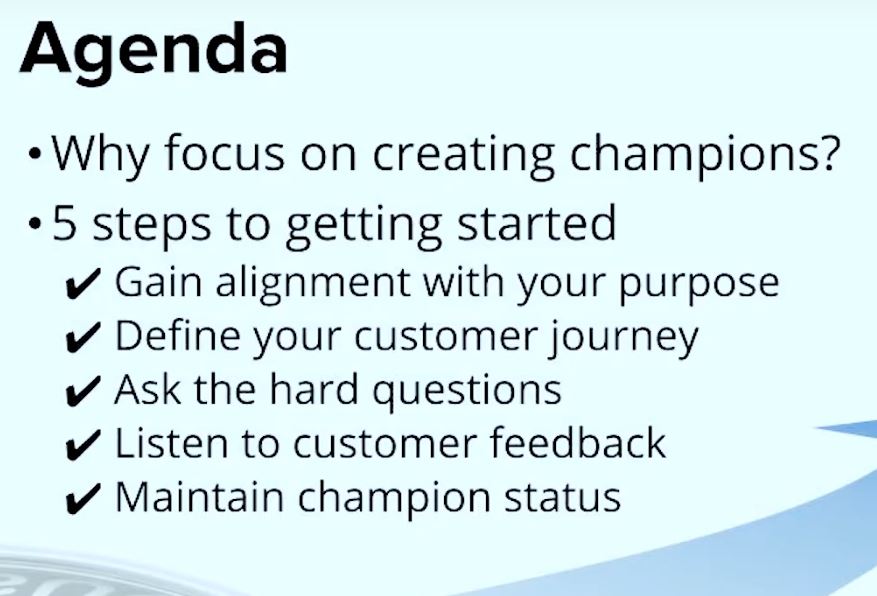
One of the things that I think is really important is that you have to be thinking about this from day one. And when you think about that, why are you focused on creating champions isn’t just good enough to have successful customers? Well, when you create champions, you do a number of things. Certainly you’re reducing churn. And as we’re all on the SaaS business, we understand the impact of minimizing that hole on the bottom of the bucket. The other thing that we want to do is we want to increase that customer lifetime value or CLTV because not only is that easier to sell our current customers more than acquiring new customers, but it’s a way of continuing to grow the business at a faster rate even if you’re not adding as many new customers.
Second or third is referrals. We have heard a lot of sessions today around ramping up your lead gen, accelerating marketing. If you can get your customers to do that lead gen and pipeline generation for you, that’s goodness. The other thing we know is that customers generally don’t buy without getting a reference whether it’s a backdoor, it’s a front door reference. Everything we buy, we want to know am I the only one buying this? Has somebody else bought it? Is this going to be good? Because all of a sudden we start seeing right before we cut the check, we get buyer’s remorse.
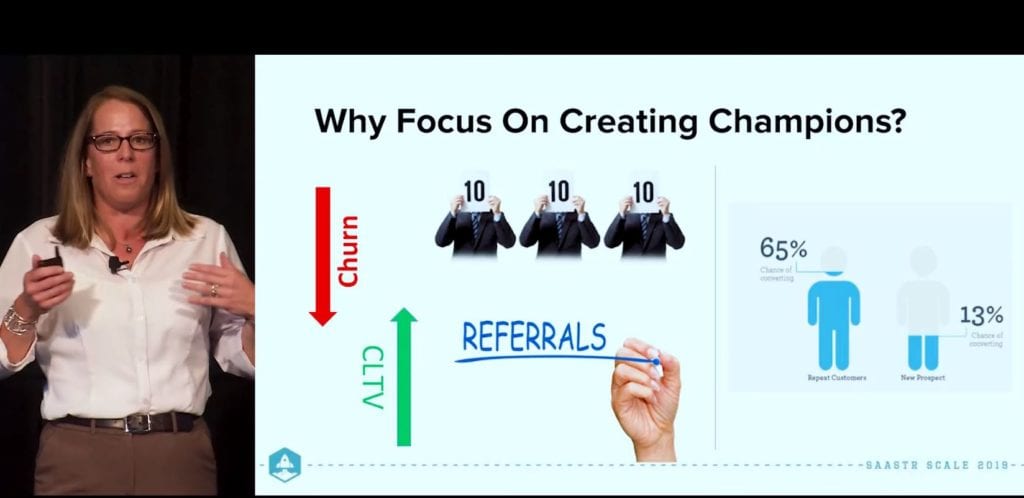 Being able to utilize these champions as references as well. And probably one of the most important things is that customers don’t stay at the same company for long periods of time anymore. And so it’s 65% more likely to convert a repeat customer than a brand new prospect. And so these are all sort of the financial reasons why it makes sense to invest the time and energy to actually create champions from day one in your business. So we’re going to go through how we do that today.
Being able to utilize these champions as references as well. And probably one of the most important things is that customers don’t stay at the same company for long periods of time anymore. And so it’s 65% more likely to convert a repeat customer than a brand new prospect. And so these are all sort of the financial reasons why it makes sense to invest the time and energy to actually create champions from day one in your business. So we’re going to go through how we do that today.
Here we go. One more time. There we go. So five steps to getting started. So the first thing you want to think about is basing your culture of your company around customer success. Second, define your customer journey. Third, you have to ask your organization the hard questions. Fourth, you need to understand the root cause issues because they’re often different than what comes out on the surface. And number five, you need to make your champion superheroes in their industry. You need to be able to give them as much as they’re giving you.
Let’s drill down a little bit deeper on each one of these. So starting with culture. How do great leaders get people to be a part of what they do? Because what you’re asking your customer champions to do is to be more than just a reference to be more than advocate. You want them to follow. You want them to be a champion for your cause. How do you do that? There’s a great TED Talk out there and I’m probably everybody in this room, if you haven’t heard of Simon Sinek, you should absolutely go watch Simon Sinek TED Talk. He’s got a number of them out there now.
But I think his first one around, starting with why it’s so relevant to businesses both internally for your employees but as well for your customers. 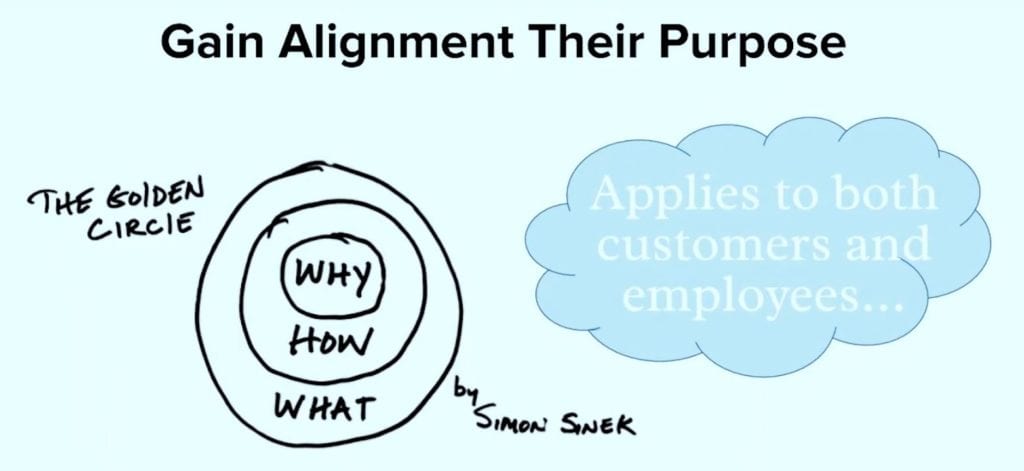 And it all starts with this concept of why are you in business, what is your purpose? And if your employees align around your purpose, your customers align around your purpose, you’re starting to do a lot more than just create a company and a product. And there’s lots of examples and if you’ve seen these TED Talks, you hear about Apple, Think Different and you hear about Salesforce in their early days and no software.
And it all starts with this concept of why are you in business, what is your purpose? And if your employees align around your purpose, your customers align around your purpose, you’re starting to do a lot more than just create a company and a product. And there’s lots of examples and if you’ve seen these TED Talks, you hear about Apple, Think Different and you hear about Salesforce in their early days and no software.
And there’s a lot of companies out there. Lego has some too. I mean there’s a lot of them that have a purpose. And so aligning with what you’re trying to do at Sage Intacct/Sage People, we’re transforming the way people think and work so their organizations can thrive. And that applies internally to our colleagues, internally in the organization, our partners, our customers, and we align our whole organization around that.
You need to be able to do that for a second reason, which is you want to sign up customers who are passionate about what you do, that believe in what you do. So most of my career was over the last 10 years was that Sage Intacct and we sold accounting software. How many people get excited about accounting software? I think I was the only one who raised my hand. Okay, we got two or three people. But it’s not so much about the software, it’s what we’re doing for people. It’s the ability to give them the weekends back. To go catch their son or daughter’s soccer game. To not have to constantly be working nights and weekends. It’s what is your purpose behind that?
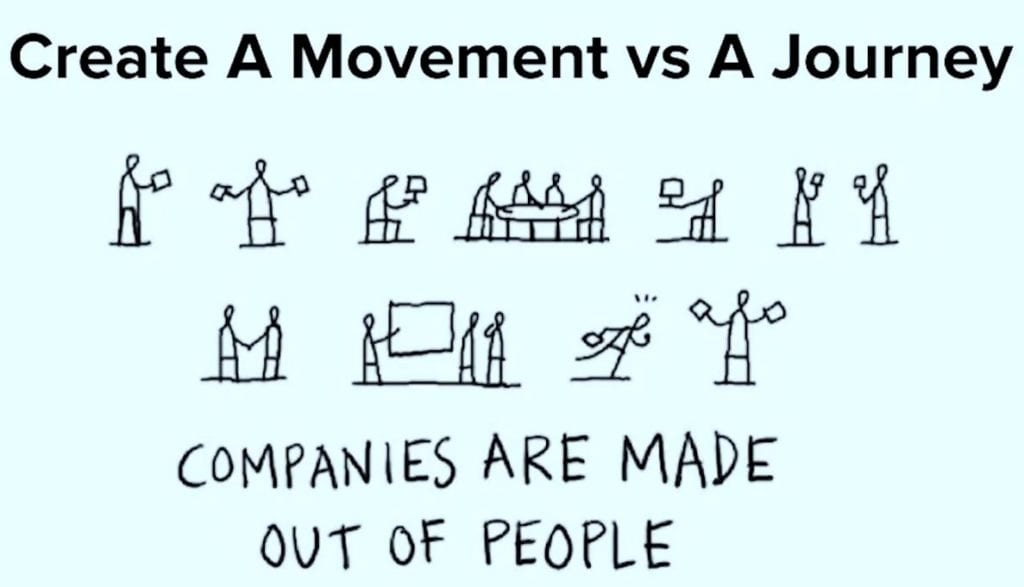 And so as you think about that, it’s important because you’re looking to create a more of a movement, not just a journey. And when you think about champions and those reference accounts, they’re not companies that are references. It’s the people at those companies. And we all know that we’ve had those situations where, Oh, such and such company is a great reference account. Well then that person who was the key reference because it was a person, not the company leaves. And if you don’t have the relationship with those people, and ideally more than one champion on an account, you’re going to have a really challenging time.
And so as you think about that, it’s important because you’re looking to create a more of a movement, not just a journey. And when you think about champions and those reference accounts, they’re not companies that are references. It’s the people at those companies. And we all know that we’ve had those situations where, Oh, such and such company is a great reference account. Well then that person who was the key reference because it was a person, not the company leaves. And if you don’t have the relationship with those people, and ideally more than one champion on an account, you’re going to have a really challenging time.
This is about making that connection with the customer and the limbic part of the brain, the emotional part of their brain to get that connection and to get them onboard, to get your employees connected to your purpose, to get them onboard with what you’re doing. And that’s how you start to drive that culture of customer success. Because it’s not so much focused around X, Y, Z NPS score. It’s focused on how are we changing the lives of our customers and improving those outcomes regardless of what your product is.
If we think about the second line and I know you may think I’m contradicting myself here, because now I’m talking about defining your customer journey, but you do need to define a journey, but it can’t simply be the steps that a customer goes through. You have to add those prior elements to it. When you think about defining your customer journey, you have to define those milestones that the customer is going to go through from their viewpoint. If you sat and you said, “Okay, we sign a customer, we process their contract, we have to get them provisioned. Maybe, maybe not. There are services that need to happen. And then we transition them to support and then we give them to the account manager and then we do their renewal. If we’re lucky we do some add ons and we do another renewal.”
That’s from the inward perspective. You need to define this from the customer’s perspective. What are they going through? What are those concerns? What are they going to have to do within their organization to have a successful journey with your product? The second thing you need to do is to agree on the internal and external stakeholders. So who are the folks within your organization that are accountable for that customer success throughout that journey?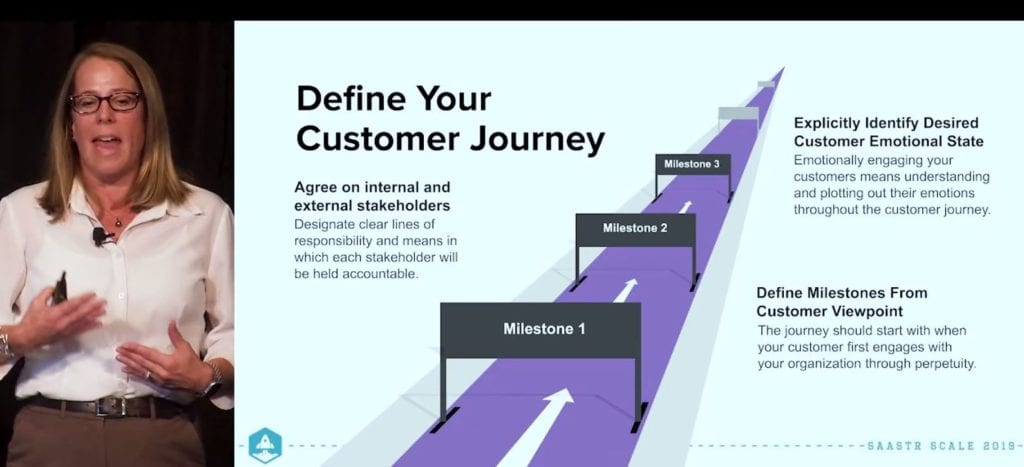
And you should be thinking about this journey from the first time that customer interacts with you because you never got a second chance at that first impression. So when that MQL first comes in, what’s that experience? What’s the experience at the 20th, 30th year renewal? We all hope we have customers that long. But it’s important to understand those stakeholders both internally and externally in the organization.
The third thing to think about as you’re plotting out your customer journey, and if you Google it, there’s lots of examples of customer journeys. But the third piece you want to make sure you have in there, and this is a really important one, and as we talked about in the culture piece, it’s important to have an emotional connection with your customer to understand what is their emotional state at any given point within their customer journey with you.
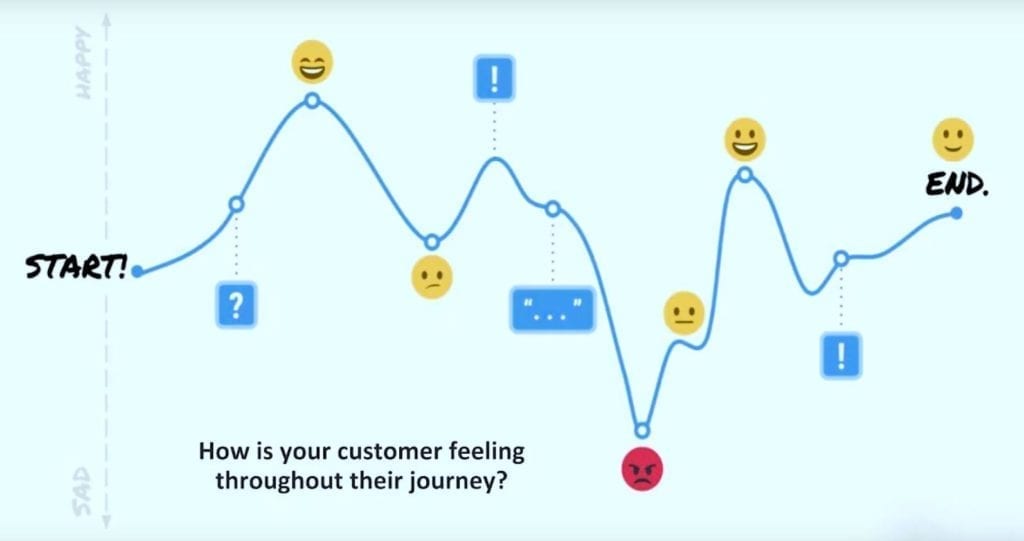 You need to be very explicit about are they an MQL? Are we about ready to close the deal? Are we just getting ready to go live? Are we processing a renewal? Have they just done an acquisition? You need to think about what are all those points? How are they feeling likely versus how do we want them to feel? For example, if you’re getting ready to close the deal, sales team’s pretty darn excited. They got a verbal, they’re like, we’re going to get a contract this is a scrape.
You need to be very explicit about are they an MQL? Are we about ready to close the deal? Are we just getting ready to go live? Are we processing a renewal? Have they just done an acquisition? You need to think about what are all those points? How are they feeling likely versus how do we want them to feel? For example, if you’re getting ready to close the deal, sales team’s pretty darn excited. They got a verbal, they’re like, we’re going to get a contract this is a scrape.
The customer, on the other hand, especially having sold to CFOs for the past 13 years who’s very pragmatic risk averse buyer, they’re quite, Oh crap, I got to make a decision that my career is on the line for, should I do this? Should I not? Maybe I’ll just hold off and hire three more people to do the work. You need to be thinking about what are those feelings they’re likely going to have. They probably will be that you want them to have and figure out what can we do through that journey to help mitigate and create the kind of emotional state that we want that prospect to have.
A really good example of this is going through from that MQL state all the way through to the xth renewal and what are those things that your type of customer along the way tends to hit. Now, I’ve pulled an example of one of these, and this is where I can spend a lot of time on this, but I’m sure you’ll get access to the slides. This is an example and you would probably drill down on each one of these, but from marketing, what are the touch points, what’s the emotional state they’re looking to have all the way through and including who are those stakeholders?
So once you have your journey to find and you’ve set up your culture and you’re starting to scale that organization. The other thing you have to do, and this is so hard to do for a lot of organizations, is you have to ask yourself the hard questions. 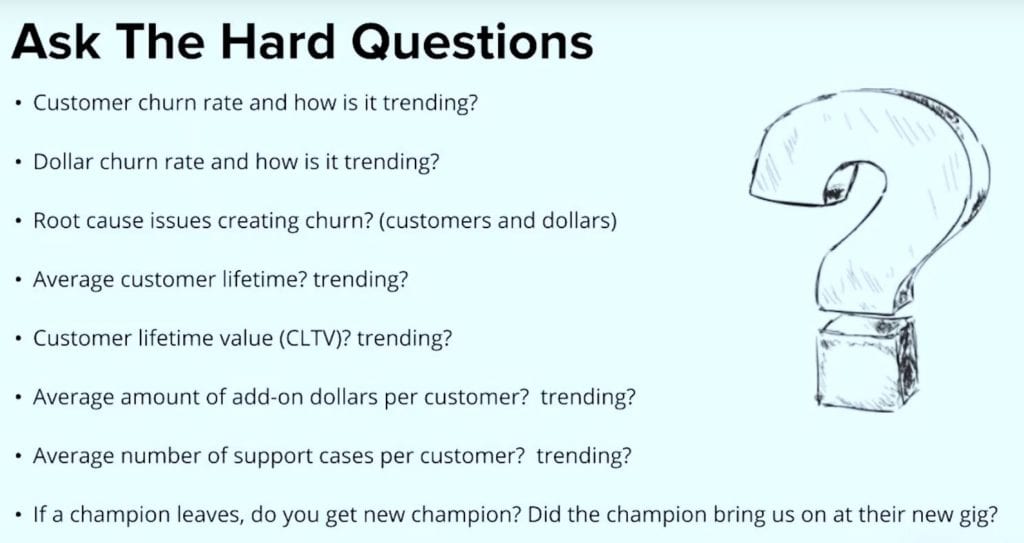 And those are things like what is our churn rate? How is it trending? And every question you ask yourself, you have to ask yourself, how is it trending? And there’s the obvious ones around dollar and logo churn, which I think we all know about, but what’s our average customer lifetime? How is that trending? What does our customer lifetime value, how is that trending? What are the average amount of add-ons per customer per year? Average number of support cases and one that I love, and it’s really easy to track these days if you set it up correctly in your systems.
And those are things like what is our churn rate? How is it trending? And every question you ask yourself, you have to ask yourself, how is it trending? And there’s the obvious ones around dollar and logo churn, which I think we all know about, but what’s our average customer lifetime? How is that trending? What does our customer lifetime value, how is that trending? What are the average amount of add-ons per customer per year? Average number of support cases and one that I love, and it’s really easy to track these days if you set it up correctly in your systems.
When we have a champion leave, are we able to easily create a new champion and that champion who left, are they taking us to their new organization? Because that’s the definition of a true champion. Is they’re the customer that brings you to every single company they go to and with the rate at which people change jobs in the market today. That can be another form of virality to help scale your business and really get the value out of the champions you’ve invested in.
So now when you ask these hard questions, you’re likely going to hear some real evil things you don’t want to hear, but don’t be a monkey. They hear no evil, see no evil, speak no evil. You have to be aware, you have to listen, and you have to talk about the bad things your customers are saying about you. And sometimes it’s really hard to hear, especially if you’re a founder and somebody tells you that your baby’s ugly or it doesn’t work very good or there’s not good product market fit, but you have to listen. And if you do, there’s lots of ways in which you can gather that information.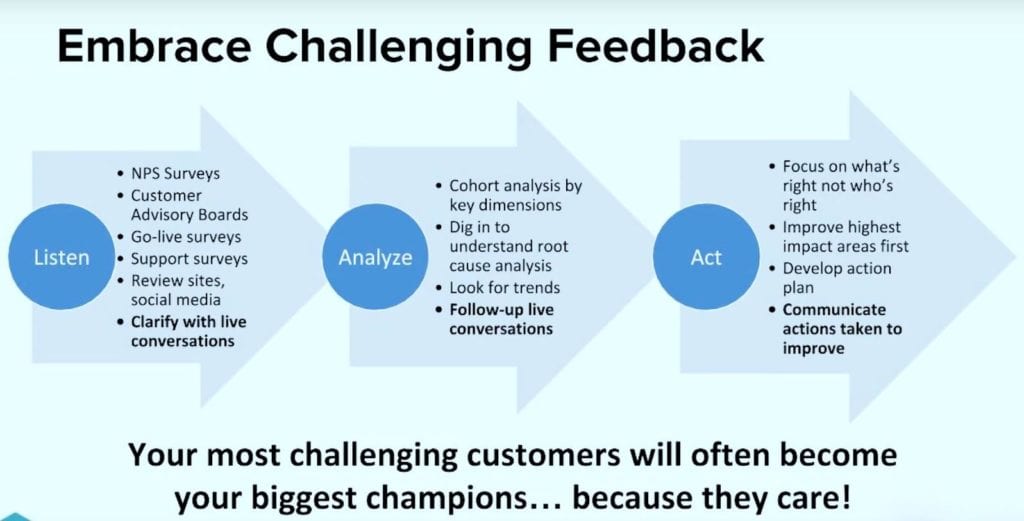
So listening through NPS surveys, customer advisory boards, go live surveys, support case surveys. I mean there’s so many ways in which we can gather these touch points. The most important piece is that if you’re gathering all this data and likely it’s sort of a self service format in which your customers are responding to written text. It’s important that you clarify with live conversations because it’s really easy for a customer to not fully be able to articulate what they’re thinking, what they’re feeling. So wherever possible, dive in, spend the time and resources to have live conversations as followup.
Because what you then need to do is analyze that information. You need to look at it by cohorts. Is there particular sizes, shapes, flavors of our customer base that are experiencing this more than others? Are there particular trends? Is this related to a new product release we did? Is this related to a new service program we rolled out and that could be either good or bad, right? We’re kind of joking about it all being bad, but there’s some really good stuff.
Well, how do you go do more of that if you don’t know that it’s really good stuff, it’s hard to go do more of it. And the most important piece for your customers, if you really want them to be champions, is you have to act. If somebody took the time to provide you feedback, positive or negative, and they don’t feel like you’ve listened and they don’t feel like you’re taking action on it, that’s the fastest way to turn off a champion. And you have to be able to communicate back to them the actions you’re taking that you appreciate that they actually care enough about your organization to provide that feedback.
As you’re thinking about this and you’ve got the feedback, you’ve listened, you’ve acted, you’re taking that into account. How do you help those customers maintain champion status? So there’s a couple of different things. So first it really requires current feeding over time. It’s not simply we got the customer, we got them live, they became a hero in their organization, but as we know, the moment a customer goes live with an implementation, the chances of that implementation continuing to meet their needs going forward dramatically goes down Hill. You know why? Most of us are selling to growth organizations, and I don’t know about you, but the last growth organization I was at, including the one I’m at today, the way it looked when I first bought the product versus when I went live with the product has dramatically changed.
The customers’ needs are constantly changing and you have to stay involved with them, make sure that their implementation is continuing to meet their needs, make sure that you are continuing to help them become a hero. And this has to be something that is both helping them as an organization. But again, we talked about champions being people. So it has to be personal. So I’ll tell in my career in driving customer success at Sage Intacct, I have probably helped dozens of people and I’m sort of going through the mental list in my head, but I can’t count that high on this, cold medicine.
Actually get promotions and there’s nothing more exciting than following up with one of your customers to find out that the work they did with your product, got them a promotion. And you can imagine the amount of passion, of energy, the mental connection they have with you and your product because it’s helped drive their career. And regardless of what product you sell, you’re going to be able to create champions where you can help be a career game changer for them.
And so you need to make it personal, need to find ways in which as you develop your customer programs and define that journey, that you have the ability to help give back to them as well. The other thing is that, and most of us in this room we’re scarce on resources, right? It’s not like we have unlimited funding and we have to work with an in expense envelope. All of these things sound great, but how do you do them? And listening to the lady talk earlier this morning around Talkdesk and the customer reference program. How do you get those one to many interactions? It’s the same thing around creating customer champions. How can you create scale? How do you get engagement with all of your champions and get them doing stuff for you without having to have this massive customer marketing team?
There’s great platforms like Influitive. There’s great ways in which you can leverage things like GT Crowd Crop Tara, Trust Radius. What are those programs in which you can start to find ways in which you get scale at getting your champions engaged and making them feel a part of your community, making them feel a part of your movement. One of the things to keep in mind is while different generations and different functional areas depending on what role you’re selling to are going to want to be engaged with differently.
Unfortunately for us at Sage Intacct and a little bit at Sage People as well, because we went from selling to the CFO to the leader of HR who typically reports to the CFO. They don’t like to do online game stuff. They don’t want to be with the community thing. They want you to personally engage with them one on one. They’ll personally engage in references. And so as you think about your constituent of champions, how do you need to treat each of them? And depending on what their role is, what their tenure is, what their generation is, you’re going to have to develop a multifaceted program in which you can do that and leverage technology or platforms wherever you can to help maintain that.
One of the key things is that the champion should not go away when they leave your business. There’s a great product called LinkedIn out there. It’s really easy. If you’re following your customers, you’re going to get notified when they changed their LinkedIn profile. You should be capturing that. If you really want to maintain them as a champion status, send them a followup note when they get to their new company, let them know, say, gosh, so sad that you’re leaving XYZ company. We had a great relationship with you there. You were such an advocate for us with love. If there’s the opportunity to talk to you about how we can help you with this at your new organization, send them a cookie, send them a Starbucks gift card, or something. Those are the champions that are going to help you continue to drive the business and you need to treat them like champions. Even if they’ve left that organization.
One of the best ways in which to do that is if you have the relationship with these folks, you can actually sometimes help them get into their next new job as well, so find ways in which you stay in contact with them even when they transition from your organization. And with all of the social networking tools available today and the way they plug into the CRM systems, it’s really easy to actually do that. You just need to sit down and have some thoughtful steps in place of how you make that happen. So with that, we have a few minutes left for questions. So happy to take any of those. I don’t think we have a mic, but I’m happy to … We do have a roving mic, look at that. So happy to take any questions.
That’s such a great question because one of the things that I think makes the successful SaaS organization as you’re scaling up from one to 10 to 20 to 100 million is you have to remain maniacally focused on what your purpose is and what are your priorities. And this is one of the things we did at Sage Intacct. Every quarter ruthlessly prioritizing where are we spending time, resources and investments, and what is the set of customers we’re looking to serve?
When you’re getting this feedback, you have to say, “Okay, if we’re very clear around our purpose, if we’re very clear about the customer trying to serve and what we’re trying to do, are these additional things that the customer’s asking for valid whereby they are requirements that fit that cohort of customers we’re talking about? Or do they sit out here to the side.” And it’s really easy to say, “Oh we’ll be shortsighted. We want the sale, we want to go get these customers.” But if it deters us from our longer term strategy, the opportunity cost is huge in terms of what you’re giving up to get one little sale. You’ve one big sale to the lifelong strategy of your company.
And then that’s where you have to really have amongst your executive team the ability to have those constructive hard conversations and challenge each other. I mean this is where I go back to everything revolves around alignment, around purpose and what you’re trying to do and defining what is your ideal customer profile and why and … Because you’re going to have to challenge yourselves a lot around what should we do or not do when it comes to that. And including, are we trying to do things on the customer journey that aren’t part of our business, right? Are we better to get partners to go do that? That’s a great question. Any additional questions? Over here?
That is such a great question. And I wish I had this like magical answer that said, Oh my God, yes, we totally have that all figured out. But no, there’s not. But let me tell you what we did do. And so a lot of it revolved around really understanding the nuances of that customer. So where are they at as a business? Where’s the business trying to go? What are the businesses goals? What’s this person’s role in that? And we’ve frankly provided coaching to them around helping them understand both from a … And we have a customer value team that helps our customers understand what’s the value and impact of their implementation of our product and services. We worked with them to help them build the case for the impact that their decision and their team and their leadership had on the organization.
And so when they went back to report to the board and exec team around what’s the impact of this investment we made in a new accounting and financial management system. They had this great story to go tell. Could they have come up with that on their own? Probably not. But we have really great value gurus and marketing people that help them create that and pull that out and put that together.
I should say we actually do have a little bit of a program around how we go do that because it becomes sort of formulaic where you can go in and you help the customer understand that and you help them understand how they can utilize that data to go help promote the benefit of what they’ve done. And that will often in itself help drive the career growth opportunities for them. Because we’re all probably bad at self promotion, majority of us are bad at self promotion. So helping them have that ammunition to go promote the benefits of what they’ve been doing. That’s a great question.
It’s a planted question. That’s actually a very good point. One of the fundamental things, and you can debate this if you’re a founder or CEO and how you want to implement this in your organization, but one of the things that Sage Intacct did very early on in the organization is there’s two things that every single person in the organization has a bonus tied to.
So they have their personal objectives, but then they have a portion of their bonus that’s split between hitting the company bookings number and hitting the company NPS score. So if you’re an AR clerk, you’re an engineer, you’re in legal, you’re in sales, wherever you’re at in the organization, everybody is tied to an NPS score. Every company meeting where we review where we’re at, where we’re review what we think the contributors were to that and every functional leader reviews with their department what can we do to improve that NPS score.
And so it has to be … Going back to what Jason said earlier, NPS should be one of the top scores that you measure your company on. And whether it’s perfect or not, and believe me, ours was certainly not perfect, but you know what, it was consistent and we could understand how it was directionally changing. I think that’s a really good strategy for making sure everyone in the organization is aligned around customer side. Any additional questions? We got one in the middle here.
One, they have a higher degree, no. Supersmart people, but they’re basically what we call value engineers. So they’re folks that know the domain, they know the business, they’re super smart with economics and analytics and they have the ability to go in and basically interview a customer and help extract out what are the … Not only what is the hard cost savings. Well, okay, you’ve reduced the close by 15 days. You decreased your DSO. You reduced leakage in your billings and so those things saved you $1 million a year. That’s the easy piece.
The other piece is by spending less time on having to do your manual processes, what’s the value of the things that you were able to do instead? And so really looking at not just the obvious hard dollar costs but going in and sort of quantifying that and building a model across that organization and being able to come up with what that is. Now, your CFO or your CEO is always going to argue about … Whether they argue about it or not, chances are, it’s still more than pays for that customer’s implementation and brings them wild savings after that.
They’re typically found in more mid-market enterprise software companies. I think of them like a business analyst who really understands the industry and the processes in which your customers are using your product for. That’s a great question. We got done a minute and eight seconds early. All right. Thank you everyone.

